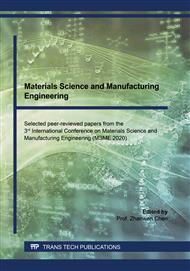[1]
H. Ohsato, T. Tsunooka, A. Kan, Y. Ohishi, Y. Miyauchi, Y. Tohdo, T. Okawa, K. Kakimoto, H. Ogawa, Microwave-millimeterwave dielectric materials, Key Engineering Materials, 269 (2004) 195-198.
DOI: 10.4028/www.scientific.net/kem.269.195
Google Scholar
[2]
X. Wang, W. Lei, R. Ang, W. Lu, ZnAl2O4–TiO2–SrAl2Si2O8 low-permittivity microwave dielectric ceramics, Ceramics International, 39 (2013) 1707-1710.
DOI: 10.1016/j.ceramint.2012.08.013
Google Scholar
[3]
R. Peng, Y. Lu, Z. Tao, D. Chen, L. Shi, Q. Zhang, Y. Li, Improved microwave dielectric properties and sintering behavior of LiZnPO4 ceramic by Ni2+-ion doping based on first-principle calculation and experiment, Ceramics International 46 (2020) 11021-11032.
DOI: 10.1016/j.ceramint.2020.01.118
Google Scholar
[4]
H. Chen, H. Su, H. Zhang, T. Zhou, B. Zhang, J. Zhang, X. Tang, Low-temperature sintering and microwave dielectric properties of (Zn1−xCox)2SiO4 ceramics, Ceramics International, 40 (2014) 14655-14659.
DOI: 10.1016/j.ceramint.2014.06.053
Google Scholar
[5]
A. Feteira, D. Sinclair, Microwave dielectric properties of low firing temperature Bi2W2O9 ceramics, Journal of the American Ceramic Society, 91 (2008) 1338-1341.
DOI: 10.1111/j.1551-2916.2008.02272.x
Google Scholar
[6]
G. Yao, P. Liu, H. Zhang, J. Calame, Novel series of low-firing microwave dielectric ceramics: Ca5A4(VO4)6(A2+= Mg,Zn), Journal of the American Ceramic Society, 96 (2013) 1691-1693.
DOI: 10.1111/jace.12359
Google Scholar
[7]
S. George, P. Anjana, V. Deepu, P. Mohanan, M. Sebastian, Low-temperature sintering and microwave dielectric properties of Li2MgSiO4 ceramics, Journal of the American Ceramic Society, 92 (2009) 1244-1249.
DOI: 10.1111/j.1551-2916.2009.02998.x
Google Scholar
[8]
R. Peng, H. Su, D. An, Y. Lu, Z. Tao, D. Chen, L. Shi, Y. Li, The sintering and dielectric properties modification of Li2MgSiO4 ceramic with Ni2+-ion doping based on calculation and experiment, Journal of Materials Research and Technology, 9 (2020) 1344-1356.
DOI: 10.1016/j.jmrt.2019.11.061
Google Scholar
[9]
K. Manu, M. Sebastian, Tape casting of low permittivity wesselsite–glass composite for LTCC based microwave applications, Ceramics International, 42 (2016) 1210-1216.
DOI: 10.1016/j.ceramint.2015.09.052
Google Scholar
[10]
T. Sasikala, C. Pavithran, M. Sebastian, Effect of lithium magnesium zinc borosilicate glass addition on densification temperature and dielectric properties of Mg2SiO4 ceramics, Journal of Materials Science: Materials in Electronics, 21 (2009) 141-144.
DOI: 10.1007/s10854-009-9882-7
Google Scholar
[11]
B. Hakki, P. Coleman, A dielectric resonator method of measuring inductive capacities in the millimeter range, Ire Transactions on Microwave Theory & Techniques, 8 (2003) 402-410.
DOI: 10.1109/tmtt.1960.1124749
Google Scholar
[12]
C. Zhang, R. Zuo, J. Zhang, Y. Wang, J. Jones, Structure-dependent microwave dielectric properties and middle-temperature sintering of forsterite (Mg1-xNix)2SiO4 ceramics, Journal of the American Ceramic Society, 98 (2015) 702-710.
DOI: 10.1111/jace.13347
Google Scholar
[13]
V. Gurevich, A. Tagantsev, Intrinsic dielectric loss in crystals, Advances in Physics, 40 (1991) 719-767.
DOI: 10.1080/00018739100101552
Google Scholar
[14]
S. Penn, N. Alford, A. Templeton, X. Wang, M. Xu, M. Reece, K. Schrapel, Effect of porosity and grain size on the microwave dielectric properties of sintered alumina, Journal of the American Ceramic Society, 80 (1997) 1885-1888.
DOI: 10.1111/j.1151-2916.1997.tb03066.x
Google Scholar
[15]
M. Guo, G. Dou, S. Gong, D. Zhou, Low-temperature sintered MgWO4–CaTiO3 ceramics with near-zero temperature coefficient of resonant frequency, Journal of the European Ceramic Society, 32 (2012) 883-890.
DOI: 10.1016/j.jeurceramsoc.2011.10.042
Google Scholar


